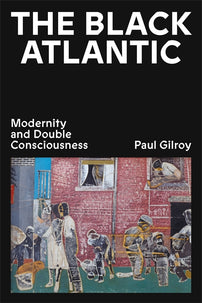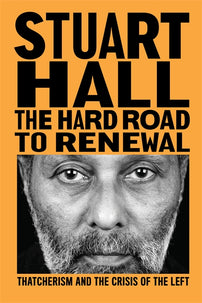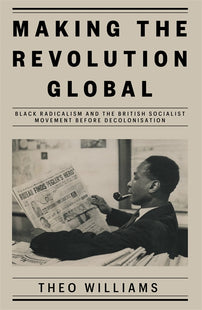The Black Atlantic at 30
Published 30 years ago this year, Paul Gilroy's seminal book The Black Atlantic profoundly shaped how we understand race and culture in contemporary society.

Black women had to deal with ‘post-modern’ problems in the nineteenth century and earlier — Toni Morrison
In January 1993, Bill Clinton was inaugurated as the 42nd US President and the largest hurricane ever recorded in the Northern Atlantic hit the shores of Britain. At the same time, while the international media ran stories of oceanic wind oscillations, sleet-beaten oil tankers, and an ascendent neoliberal politics of the “Third Way,” a young British intellectual called Paul Gilroy was busy mapping a very different kind of transatlantic movement.
Published 30-years ago this autumn, Paul Gilroy’s The Black Atlantic follows the intercontinental migrations of artists and writers like Frederick Douglass, WEB Du Bois, Richard Wright, Martin Delany, Jimi Hendrix, and others as they journeyed back-and-forth across the Atlantic throughout the nineteenth and twentieth century, forging along the way a convivial and complex corpus of Black Atlantic culture. Modelled on the tumultuous dynamism of a diasporic “sea voyage,” the book folds facets of African, American, British, and Caribbean culture into a single “rhizomorphic fractal structure” of black multiplicity: black art, black literature, black music, black philosophy, black vitality, black identity.
The range of academic and mainstream journals, magazines, and newspapers that reviewed and revered The Black Atlantic upon its release in 1993 bears testimony to the book’s remarkable impact. Alongside the flagship journals of the American Anthropological Association, the British Sociological Association, the Modern Language Association, and the Modernist Studies Association, for example, The Black Atlantic was lauded in the pages of The Guardian, The African American Review, The London Review Books, The Washington Post, The Black Scholar, The New Statesman, The Nation, Postmodern Culture, and elsewhere.
The Black Atlantic is a complex historical object. Its background is the entangled and ongoing legacies of cosmopolitan neoliberalism, Thatcherism, and an increasingly insular British conservatism. But it also functioned as a pivot point between a hegemonic post-modernist critical theory that was ubiquitous in academia during the 1980s and the absorption of aspects of these critical theories within the more politically agential, environmentally conscious, and historically situated schools of black studies, queer theory, feminist studies, and ecological philosophy that proliferated in the 1990s, 2000s, and beyond.[1]
*
Paul Gilroy was born in the East End of London to Guyanese and English parents in 1956. His mother, Beryl Gilroy, was a celebrated teacher, psychologist, poet, and novelist who moved to Britain in 1952 as part of the Windrush Generation. His father, Pat Gilroy, was a chemist, a conscientious objector during World War II, and a communist who left the party following the USSR’s invasion of Hungary in 1956. Gilroy has spoken of formative childhood memories from this period, of reading EP Thompson’s The Making of the English Working Class while at school, and of growing up in an urban milieu surrounded by Holocaust survivors, Teddy Boys, skinheads, European Voluntary Workers, and individuals from across the former British Empire. “We had enormous numbers of South African refugees,” Gilroy recalled in 2020, “we had Cypriots, we had Sikhs, we had Caribbean folks, we had Indians, and the flats where we lived were full. There was obviously a turnover among the other tenants, and so I was exposed to all manner of things.”
It was during the 1970s that this formative exposure to a broad and nationally varied community collided with a burgeoning interest in Stuart Hall’s pioneering work in cultural studies. Gilroy first encountered Hall’s writing while an undergraduate in English Literature at the University of Sussex in the mid-1970s by reading the edited collection, Resistance Through Rituals: Youth Subcultures in Post-War Britain. By the early-1980s, he was conducting a PhD with Hall at the University of Birmingham’s iconic Centre for Contemporary Cultural Studies (CCCS).
Founded by Richard Hoggart in the late-1960s, today the CCCS is celebrated for its role in the history of British cultural studies, bringing rigor to the interdisciplinary study of post-war sub-cultures, and heralding a remarkable influence across late-twentieth century British culture, from the feminist criticism of Angela McRobbie to the later cultural theory of Mark Fisher’s K-Punk blog. Speaking of his time at the CCCS in 2013, Gilroy recalled the Centre’s reputation in the late-1970s and early-1980s “for a certain kind of openness and a certain sort of leftism” that appealed to his developing interests in high and low cultures, as both a promising scholar of the sociology of literature and as a politically engaged activist involved in countercultural movements like Rock Against Racism.
The significance of the CCCS to Gilroy’s intellectual development is epitomized by his output in the 1980s, first as co-author alongside Hall in the official CCCS publication, The Empire Strikes Back, and more extensively in his first monograph, There Ain’t No Black in the Union Jack. In the latter, Gilroy problematized existing sociological theories of “new racism” and sought “to introduce a more sophisticated theory of culture into the political analysis of ‘race’ and racism in Britain”. The result is a breath-taking 400-page riot of Enoch Powell speeches and Daily Mail snippets, Frank Bruno soundbites, punk ‘zine cut-outs, and Met Police Commissioner reports. At one moment, Gilroy homes in on a black British nurse who received a rapturous standing ovation at the 1985 Conservative Party conference after declaring, “I am a Conservative, black and British and proud of all three.” In another, he folds the Rastafarian roots of punk into a critique of a National Front article that insisted that punk is “totally white in origin”. Flickering between the moronic diatribes of Bradford Headmasters and the optimism of “Reggae Soul Rock and Roll Jazz-Funk and Punk” concerts, throughout There Ain’t No Black in the Union Jack Gilroy calls for both the destruction of a fusty “British nationalism which is stained with the memory of imperial greatness” and the complication of cartoonish conceptions of black identity pedalled not only at the behest of said nationalists, but also of nascent neoliberal ideations of “superficial pluralism”.
[book-strip index="1"]
By the early-1990s, Gilroy expanded these rhizomorphic interests further still, complicating the intellectual valences of Britain’s “homely cultural studies”—inflected primarily by the work of Hall and Thompson—by attending to a far larger trans-national syncretic field of North American, Western European, African, and Caribbean cultures. Again resisting “absolutist definitions of ‘race’ and ethnicity” in favour of a more dynamic and complex understanding of the cultural entanglements that shape racism and nationalism, The Black Atlantic’s ground breaking investigation into the shifting and multitudinous dimensions of black experience in a modern and postmodern lifeworld are riven and grooved with Gilroy’s own experiences of the animate complexities of race in post-war London, as well as his academic training in cultural studies and the sociology of literature.
*
The Black Atlantic’s post-nationalist dynamism can easily be contextualized today as something of a punkish riposte to the insidious jingoism animating the moment of its historical emergence at the fag-end of Thatcher’s Britain. After all, The Black Atlantic first shook the shores of Little England at the very moment that an emergent right-wing nationalism began again to gain ground (the BNP won their first council seat in Tower Hamlets in September 1993) and John Major’s Conservative government continued to sink Britain further into socioeconomic crisis (unemployment forecasts surpassed 3.5 million in January 1993).
In turn, while The Black Atlantic decentres rigid nationalist frameworks, it equally resists the depthless internationalism of a hypercommodified neoliberal cosmopolitanism that erupted from the same late-twentieth century moment. Instead, Gilroy attends dexterously and sensitively to the different striated forms of “double consciousness,” a phrase he borrows from W.E.B. Du Bois, that define and redefine the transcultural dynamics of black experience throughout the nineteenth- and twentieth-centuries. Owing to these mottled and variegated rhizomorphic foundations, The Black Atlantic is a complex conjunction of ordered disorder. Here, “Rasta thrash punk band[s]” collide with Wyndham Lewis’s belligerent English Vorticism and “Hendrix’s neo-minstrel buffoonery” bristles alongside the “black femininity of Du Bois’s cultural cosmology”. Yet the result is never flat, homogenous, smooth, or in any sense diluted. The Black Atlantic writhes with precision and complexity as it traverses and excavates its variegated milieux, at once theorizing and performing a “complicity and syncretic interdependency of black and white thinkers,” and moving always with a rigorous polymathic intensity that both belies and explodes the “homely cultural studies” of the CCCS.
We might begin to better understand The Black Atlantic’s multi-morphic analysis of such “countercultures of modernity” by highlighting the text’s seamless mixture of academic and popular tendencies. There is on the one hand the fastidiously intellectual “Academic Gilroy,” sensitive to the cadences of Richard Wright’s prose, attuned to the transcultural nuances of Sartrean and Du Boisean thought, and at home with the readers and editors at Harvard University Press. On the other, there’s the more roguish and countercultural “pop modernist” Gilroy, attuned to the misogyny of 2 Live Crew, pitting Theodor Adorno into head-on-collision with Kool G Rap.[2] Appositely, Gilroy’s pop modernist mode is further showcased in another text also published in autumn 1993, the essay collection Small Acts distributed by the leading purveyor of 1990s countercultural expression, Serpent’s Tail. Turning to the “multiplicity of black tones and styles” enriching late-twentieth century British culture, Gilroy wears his academic training lightly throughout Small Acts—riffing variously on the photography of David A Bailey and the “peculiarities of the black English”—while engaging in the same project of “politicized postmodernism against the spurious certainties of racial realism” that underlies The Black Atlantic. Indeed, Part 3 of Small Acts even concerns itself explicitly with “Black Atlantic Exchanges” in a series of essays on Spike Lee, black kinship, and a remarkable interview with Toni Morrison.
Gilroy’s ease at traversing cultural, intellectual, and stylistic modes puts him in the company of contemporaneous black and feminist thinkers like bell hooks and Cornel West alongside more countercultural pop modernists like Ian Penman and Kodwo Eshun. In turn, this complex mixture of styles and references, that both confronts globalization and resists its flattening tendencies, gestures toward Gilroy’s wider oppositional although sympathetic relationship with the period’s post-modernist cultures.
*
As Russell A. Potter wrote in his review of The Black Atlantic for Postmodern Culture, Gilroy may skewer contemporary critical vogues by resituating conceptions of postmodernity as an “anti-modernity” or a “counterculture of modernity,” but The Black Atlantic nevertheless “raises questions which are absolutely fundamental to postmodern theory and practice.” By extension, contextualizing The Black Atlantic attunes us to the overlooked significance of what Gilroy refers to as the text’s complicity with a “politicised postmodernism” (a phrase repeated in Small Acts), and which also speaks toward the 1990s as an intellectual moment when many sought to move beyond the more apolitical postmodern theories of the 1980s. Notable in this regard are works like Stuart Hall’s “On Postmodernism & Articulation”, Cornel West’s “Black Culture and Postmodernism”, Figures in Black by Henry Louis Gates, and bell hooks’s “Postmodern Blackness”, in which we can sound the first stirrings of a self-reflexive movement in black studies that attempts to be both “inside and outside” dominant post-modernist schools of critical theory in thrall to abstract discussions of heterogeneity, deconstruction, polysemy, difference, and multiplicity.
[book-strip index="2"]
The work of hooks seems especially vital to the black feminist mode of politicized post-modernist theory that can be said, in part, to animate The Black Atlantic. Born like Gilroy in the early-to-mid 1950s, hooks first came to the fore of American academia with Ain’t I a Woman?: Black Women and Feminism, published in 1981, as well as Feminist Theory: From Margin to Center from 1984, and 1990’s Yearning. “It is sadly ironic,” hooks writes in her essay “Postmodern Blackness”, that “the contemporary discourse which talks the most about heterogeneity, the decentered subject, declaring breakthroughs that allow recognition of Otherness, still directs its critical voice primarily to a specialized audience that shares a common language rooted in the very master narratives it claims to challenge.” Postmodern theory may well have rendered ideas of multiplicity, difference, otherness, and complexity in vogue, but as hooks suggests, the overarching discussion was itself narrowly circumscribed: codified by a handful of Euro-centric white male interests that hooks’s own theories of the postmodern condition both contested, deconstructed, and revitalized.
It is against this backdrop that we find The Black Atlantic’s radical attempts to destabilize normative late-twentieth century historical and intellectual markers of “modernism / modernity” and “postmodernism / postmodernity” via the Black Atlantic’s “anti-modernities” or “countercultures of modernity”. “Black women,” as Toni Morrison surmised in an interview with Gilroy from 1988, “had to deal with ‘postmodern’ problems in the nineteenth century and earlier” and it is a key conjecture of The Black Atlantic that should contemporary postmodern theorists adequately consider the international and transcultural fracas of black experience following “the unspeakable terrors of the slave experience,” orthodox understandings of the prototypical “postmodern condition” would need to be radically revised.
To be sure, Gilroy’s resistance to the “banal relativism” of an “easy postmodernism” in The Black Atlantic comes not by way of a wholesale dismissal of postmodern culture and theory but through an exacting engagement with emergent black and feminist postmodernist thinkers. One of the things Gilroy’s “politicised postmodernism” can be said to do is to develop the kind of “radical postmodernism” that hooks advocates and wherein a “politics of difference” attends, in her word, to “sensibilities which are shared across the boundaries of class, gender, and race, and which could be fertile ground for the construction of empathy-ties that would promote recognition of common commitments and serve as a base for solidarity and coalition.” Coupled with her attendant calls throughout Yearning for more “post-nationalist” understandings of “how we live as black people in a postmodern world” alongside her advocations of “marginality” as a “space of radical openness”, hooks’s black feminist post-modernism can be said to play a crucial role The Black Atlantic’s own imperative to offer an alternative or countercultural foundational text for a reconceptualized and politicized post-modernist culture.
Closely related is Gilroy’s sympathetic engagement with contemporary feminist thinkers like Jane Flax and Patricia Hill Collins. “I see this work as complementing and extending the work of feminist philosophers,” states Gilroy plainly, “feminist philosophers who have opposed the figuration of woman as a sign for the repressed or irrational other of rationality identified as male.” Gilroy is most explicit in his indebtedness to Collins, “whose argument for the existence of a black women’s standpoint epistemology is conducted in something of the same critical, reconstructive, and revisionist spirit that guides my thinking here”, before citing Flax’s 1990 text, Thinking Fragments, as a specific model for his own “politicised postmodernism” that leaves “the categories of enquiry open” and resists the “pernicious effects of dualistic binary thinking”.
Gilroy’s “reconstructive intellectual labour” in The Black Atlantic can be said to be guided, in part, by something like Flax’s and hooks’s paradoxical tendencies to at once admit and delimit dominant 1980s post-modernist theories, harnessing the political possibilities of deconstructing authoritarian forms without “being seduced by postmodernism’s claims to set free the play of differences” as Flax writes, or descending into what Gilroy himself dismisses as “arrogant deconstructions” and “anti-political post-structuralisms”.
*
The Black Atlantic also looks ahead to Gilroy’s later turn in the 2000s and 2010s to both the “planetary humanism” of works like Between Camps and After Empire, and the “offshore humanism” or “blue humanism” of his more recent essays. “A fluvial orientation promotes planetarity,” writes Gilroy in his 2019 Holdberg Acceptance Speech, “and understanding of culture alters when solid territory gives way to water”. The “rhizomorphic fractal structure” of The Black Atlantic is further liquefied, retuned for our own time of rising waters and impending mass dislocation. This “blue humanism” calls not only for the eruption of new forms of fluvial communality and liquescent collectivity in a warming world, but also a “difficult and belated deepening of democracy” that is tenaciously attached to “the overcoming of racial hierarchies, categories and styles of thought”.
In the same postmillennial period, we can see the legacy of The Black Atlantic increasingly informing the works of artists and writers as various as Isaac Julien, Ingrid Pollard, Kodwo Eshun, Ian Penman, Fred Wilson, Yinka Shonibare, Stewart Home, Ellen Gallagher, Hew Locke, Julie Mehretu, and many others. Let us end then, by turning briefly to John Keene’s sprawling collection of prose fragments from 2015, Counternarratives. Miming The Black Atlantic’s own formal replication of a diasporic “sea voyage” and cutting across orthodox distinctions of modernism and post-modernism—modernity and postmodernity—Keene’s counter-narratives carry within them the rhizomorphic deformations of Gilroy’s own “counter-cultures of modernity.” Indeed, in light of Keene’s explicit suggestion that Counternarratives is routed through “Paul Gilroy’s famous, eponymous statement on the Black Atlantic as a counterculture of modernity,” we might consider the text as a kind of promiscuous yet politically charged novelization of The Black Atlantic.
It is, in turn, in this remarkable dynamic openness to intermedial collaboration that The Black Atlantic’s legacy seems most vibrant. The Black Atlantic lives on not merely as an inanimate text, but also through the living labilities of its power to at once unite and distinguish such complex cultures as Keene’s experimental literature and Julien’s avant-garde cinema, Mehretu’s abstract expressionist canvases and Yinka Shonibare’s sculptures, all the while bringing them into dialogue with a far larger legacy encompassing Du Bois and Ellison, Baraka and Hall, Henry Dumas, and many more. To be sure, while the future of twenty-first century culture remains unwritten, a good deal of it will almost certainly continue to be both “rooted in and routed through” the “rhizomorphic fractal structure” of The Black Atlantic.
[book-strip index="3"]
James Reath received his PhD from University College London (UCL) in 2022 and is currently a Wellcome Trust Early Career Fellow in English at the University of Exeter. He has held visiting fellowships at Yale University and the Harry Ransom Center at the University of Texas at Austin. His first book, ANEXACT FORM, is currently under review.
____________
[1] This essay is a revised version of a talk given at the conference, Revival & Erasure: The Black Atlantic at 30, in May 2023, organized by the Sarah Parker Remond Centre for the Study of Race and Racism at the Institute of Advanced Studies (IAS) at University College London (UCL). I’d like to thank Lara Choksey for organizing the event.
[2] This point stems from a point made by Phoebe Braithwaite in reference to the “pop modernism” of Gilroy’s prose style in The Black Atlantic and elsewhere, in a paper also given at Revival & Erasure: The Black Atlantic at 30.


